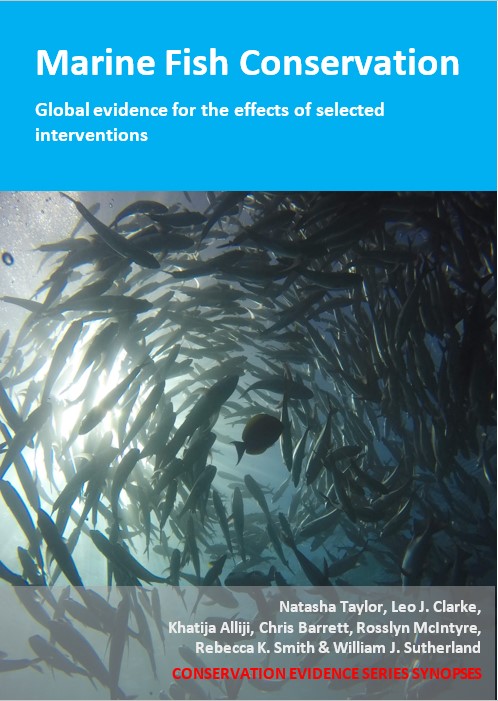Involve fishers and stakeholders in co-management
-
Overall effectiveness category Awaiting assessment
-
Number of studies: 3
View assessment score
Hide assessment score
How is the evidence assessed?
-
Effectiveness
not assessed -
Certainty
not assessed -
Harms
not assessed
Study locations
Supporting evidence from individual studies
A before-and-after study in 1996–2004 at four coral reef sites in the Indian Ocean off Tanzania (McClanahan et al. 2006) found that involving fishers and stakeholders in co-management resulted in an increase in overall fish abundance, but abundance varied between species groups, nine years after implementation compared to before. Total fish biomass was higher after nine years (2004) compared to the year of implementation (1996) of collaboratively managed reef fisheries (after: 457 kg/ha, before: 260 kg/ha). Between individual species groups, fish biomass was higher for eight, similar for two and lower for two groups (see original paper for data by species group). Data were collected from four small reefs (0.25–3.0 km2) in the Mtang’ata Collaborative Management Area in Tanzania (established in 1996) managed by gear restrictions and small voluntarily and temporary closed areas (some illegal fishing was reported). At each reef site, fish communities were surveyed twice (in 1996 and 2003–2004) by underwater visual census along two 5 × 100 m belt transects at each site.
Study and other actions testedA before-and-after study in 2012–2014 of three areas of the Tam Giang Lagoon in the South China Sea, Vietnam (Ho et al. 2016) reported that after the implementation of co-management and territorial rights for fishing, there was a reduction in the number of fishers engaged in illegal activity using destructive fishing gears compared to before. Results were not statistically tested. In all six survey areas and in all but one case, the numbers of violators using destructive fishing gears (such as electric shock and bottom trawls) from both within and outside the lagoon communities were reported to be lower after implementation of co-management (after: maximum of 10 persons and up to 8 boats/day, before: maximum of 50 persons and 15 boats/day). See original paper for data by individual area and violator origin. Co-management was progressively established in the Tam Giang lagoon system (two thirds – 13,860 ha – allocated as co-managed, rest open access) since 2002, resulting in 64 fishery associations, 34 of which also had territorial rights for fishing (first one established 2009). Data were collected between late 2012 to 2014 from surveys of six fishing communities (two each in the north, central and south lagoon areas, 252 randomly selected members of associations), supplementary interviews and focus groups with resource managers and practitioners. Survey respondents were asked whether or not there were changes to a number of social and ecological measures before and after 2009 (selected because the first territorial rights were allocated and all associations established for at least one year).
Study and other actions testedA before-and-after study in 2007–2011 of reef and lagoon areas of an inhabited coral reef island in the Pacific Ocean, Tonga (Webster et al. 2017) found that under a new co-management system with territorial fishing rights (exclusion of fishers from outside areas), total fish catch rates did not increase in the five years following implementation, catch rates of half of the six individual species groups decreased and there was no decrease in overall fishing effort. No differences in total fish catch rates and catch rates of three of six fish groups (Acanthuridae - Naso spp., Holocentridae, Lethrinidae) were found since implementation, but catch rates of the remaining three (Acanthuridae - Acanthurus spp., Scaridae, Serranidae) decreased (data reported as statistical results). In addition, no difference in overall fishing effort was found (data reported as statistical results), but the authors reported that this was likely to be due to reduced travel to fishing grounds further away by resident fishers with the new exclusive rights. Co-management formally commenced on the island of ‘O’ua (one of 170 Tongan Islands) in 2007, covering a marine area of 4,606 ha, of which 203 ha was a no-take zone. Only residents on ‘O’ua could fish the co-managed area, whereas before, there was access also to fishers from neighbouring islands and small commercial vessels from the main island group. Fish catch landings (species and weight/trip) were sampled each year between 2007–2011 (total 184 records), collected opportunistically from individual fishers (see original paper for fishing types). Catch data from spearfishing only was used for statistical analysis.
Study and other actions tested
Where has this evidence come from?
List of journals searched by synopsis
All the journals searched for all synopses
This Action forms part of the Action Synopsis:
Marine Fish Conservation





)_2023.JPG)














